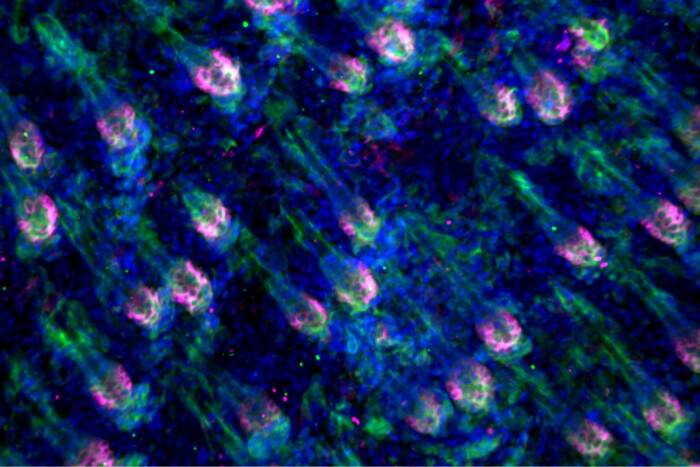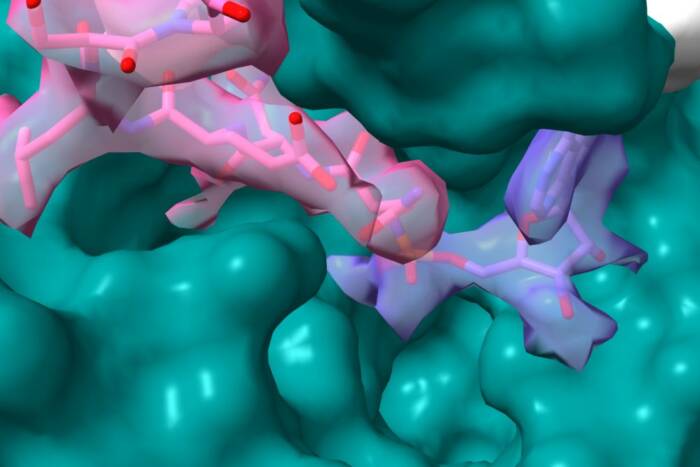Gadsby and Muir receive fourth annual teaching awards
by TALLEY HENNING BROWN
The faculty of The Rockefeller University have presided over the hypotheses, experiments and thesis defenses of nearly 1,000 students since the beginning of the graduate program in 1955. Before the Convocation ceremony on June 12, two of these mentors were recognized for their assiduous efforts on behalf of their students. David C. Gadsby, head of the Laboratory of Cardiac and Membrane Physiology, and Tom W. Muir, head of the Selma and Lawrence Ruben Laboratory of Synthetic Protein Chemistry, were presented with this year’s Rockefeller University Distinguished Teaching Awards during the Graduate Luncheon.
Established in 2005, the teaching award is given each year to one or two faculty members for contributions that have enriched the university’s educational environment. Awardees, who receive a monetary prize and a plaque, are chosen by a committee comprising the university’s scientific executive officers.
Dr. Gadsby, who is Patrick A. Gerschel Family Professor, first came to Rockefeller as a visiting student in the laboratory of Paul Cranefield. Upon graduation from University College London, where he received his Ph.D. in physiology in 1978, he was offered an assistant professorship at Rockefeller. He was promoted to associate professor in 1984 and professor in 1991. He is the recipient of an Irma T. Hirschl Career Scientist Award, a K.S. Cole Award from the Biophysical Society and a National Institutes of Health Merit Award, among numerous other honors, and was elected a fellow of the Royal Society in 2005.
Dr. Gadsby studies the mechanisms and signaling pathways that govern the transport of ions into and out of cells, research that carries implications for many essential physiological processes, including secretion of hormones and neurotransmitters, cell fertilization and volume regulation, kidney function and electrical signaling in nerve, heart and muscle cells. In 1986, Dr. Gadsby took over organization of the Neurophysiology course, now called Membrane Biophysics, which he teaches every other year with Professor Sanford M. Simon. “Dr. Gadsby basically puts his life on hold in order to organize and oversee a five-day-a-week class. He attends every lecture and runs every lab,” says Rebecca Ahrens, an M.D.-Ph.D. student who took Membrane Biophysics last fall. “And through all of it, he is constantly asking questions and pushing those around him to think about their work in new ways and to try new things.”
Dr. Muir, Richard E. Salomon Family Professor, studied at the University of Edinburgh, where he received a Ph.D. in organic chemistry in 1993, and did his postdoc and then served as a senior research associate at The Scripps Research Institute. He began his Rockefeller career as assistant professor in 1996, becoming associate professor in 2000 and professor in 2002. He is also director of the university’s Pels Family Center for Biochemistry and Structural Biology.
Dr. Muir’s laboratory uses tools of organic chemistry, biochemistry and cell biology to create new technologies for the study of protein function in complex biomedical systems. He began teaching the Chemical Biology course in 1997 and now co-organizes the class with Professor Tarun Kapoor. Chemical Biology is an essential course in the university’s interdisciplinary curriculum as it uses the tools of chemistry to explore the complexities of modern biology. Sarah Wacker, a student in Dr. Kapoor’s Laboratory of Chemistry and Cell Biology, has taken both Chemical Biology and Biochemical and Biophysical Methods with Dr. Muir. “Both of the courses he teaches are methods-based and during his lectures, I always became excited about trying out each technique on my own. The way Tom teaches simply inspires creativity,” she says.


